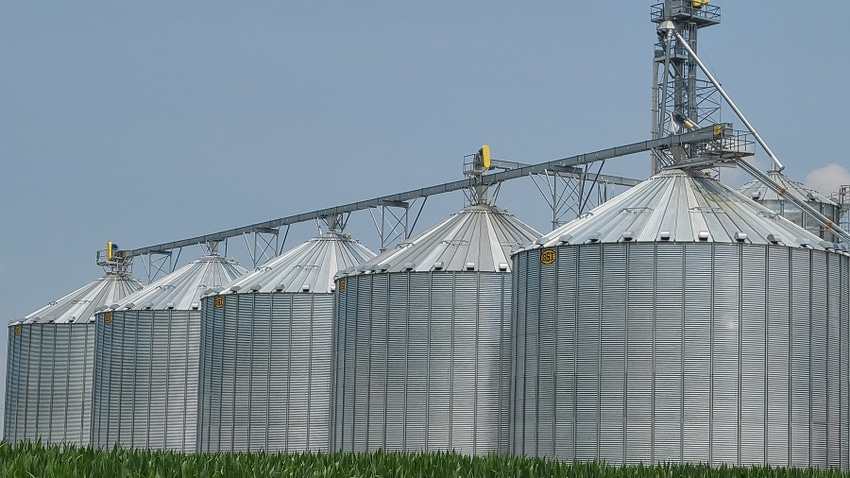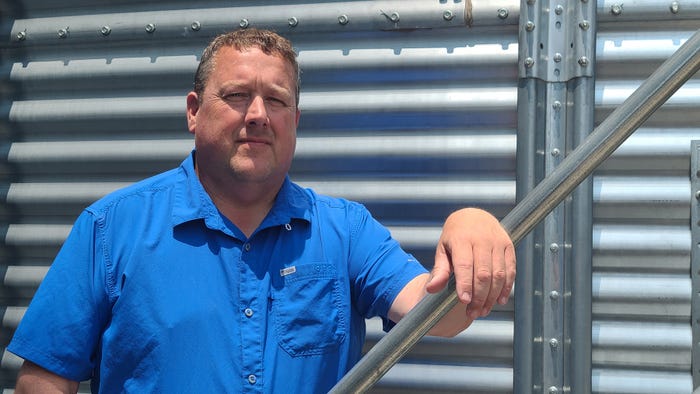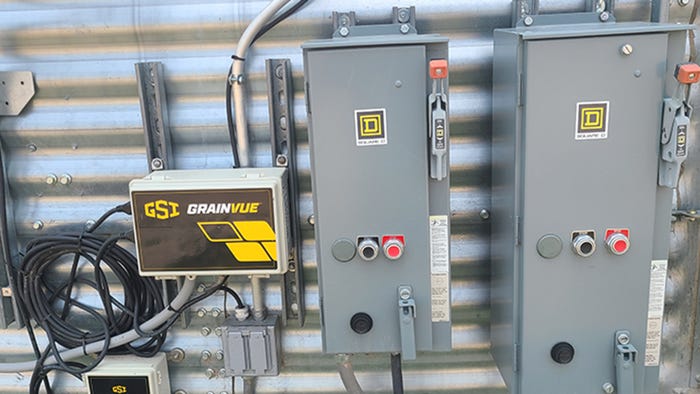
After high winds wiped out his 24-bin grain storage complex in 2020, Gideon, MO farmer Joel Brown was forced to rebuild from scratch. A year later he had a shiny new million bu. set up that included five 60-foot bins and 10 48-foot bins, each with its own cloud-based monitoring system that automatically monitors and aerates stored bin to preset parameters.
“I wouldn’t own a grain bin now without a monitoring system,” says Brown. “We have a lot of money tied up in 1 million bushels of stored grain, and I don’t want to lose it.”

“With 600,000 bu. of stored corn, it’s worth a good bit of money in terms of grain weight and energy savings,” says Gideon, Mo. farmer Joel Brown. Credit: Ben Potter
Old and new
Cloud-based in-bin monitoring systems are a combination of old and new technology: weather stations and temperature cables hanging inside grain bins (old), coupled with cloud-based software (new) that can automatically turn bin fans on and off based on presets you control and monitor from your mobile device.
Brown’s system, GrainVue by GSI, uses an on-farm weather station wirelessly tied to in-bin hanging cables through the cloud. Those cables not only monitor moisture, humidity, and temperature, they can turn fans on and off at optimal times. The result is a system that not only protects stored grain but also helps make money through additional test weight. Adoption is being driven by farm growth, higher farm incomes, and grain prices.

Joel Brown's GrainVue system. Credit: Ben Potter
“As we see farms consolidate you see bins spread all over the place, and it’s less convenient to manage them all sitting in one location,” explains Greg Trame, GSI director of technology sales. “Now with these systems you have remote data available on your phone wherever and whenever you want to.
“Your work with the crop doesn’t end when the combine goes through the field,” he adds. “That’s where these systems help not only preserve the crop until sale, but also make a little more money, for example, in rehydrating beans or not over drying corn in the bin.
“It’s making them money and it’s making the farmer’s job easier.”
David Womack agrees. The Shelbyville, TN farmer installed a cloud-based grain monitoring system on his storage bins last year, “and saved a couple thousand in fan bin run times right off the bat.”
Womack installed OPI Blue, including a weather station, temperature and moisture cables, and automatic fan control connected to his corn and soybean bins through the cloud. It automatically signals bin fans when needed. On rainy days it automatically rehydrates soybeans if they are below moisture targets Womack presets.
Womack can remotely monitor that stored grain from his smartphone or PC. He says the new system saved him money two ways since installation last year.
The management system allows Womack to manage his grain with the click of a button on a handheld device. Credit: Mike Wilson
“If you put grain in a little wet, it will turn the fans on and off automatically,” Womack explains. “In the past we might have just left the fans run for a month just to be safe. Now there’s no second-guessing.”
For Womack, those moisture monitoring cables end up saving him money by ‘knowing’ when grain is just the right moisture.
“This bin was full of corn but it was at 14% moisture when we shelled it,” Womack says, gesturing to a nearby bin. “Normally I'd run fans at least a day a week out of uncertainty. This year I hadn't run the fan hardly any; if the system needs the fan on, it turns it on.”
“I probably already saved a couple thousand dollars on electric bills just by not running fans as much,” says Tennessee farmer David Womack. “And then of course I made a few thousand bucks selling 12% moisture beans instead of 10% moisture beans. So it’s a win on two sides.” Credit: Mike Wilson
More valuable soybeans
While that smart system may lower energy costs for stored corn, it may work even better with soybeans, Womack says, pointing to a second bin. “People put beans in a bin and leave them, but beans shrink a lot,” he says. “You can put 20,000 bushels in a bin at harvest and end up with 19,000 bu. coming out a few months later.
“This bin was full of beans and they went in really dry, at 9% moisture. So, this system, on foggy mornings or rainy days, will turn the fan on to capture moisture. Over time, these beans that went in the bin at 9% will come out at 11% or 12% when we go to make sales.
“If we had left the moisture at 9% we’d be losing on each bushel.”
Tricky business
Adding moisture back into stored crops is more challenging than preventing over drying, simply because weather outside the bin is fickle. Realistically soybeans are the only stored crop you can add moisture back in to where it can pay off, says Trame.
Moving stored beans from 9% to 13% would be worth a lot of money, but you might not be able to get that all back through rehydrating,’ he says. “More realistically you might get 2%, which is still a good payback.”
On the other hand, farmers who store high moisture corn can see money leak out right away if you over dry below 15%, “And it’s easier to do that with today’s high powered dryers,” Trame says. “Farmers don’t over dry because they want to; they do it from a lack of information.”
Adam Weiss, Chief Technology Officer at OPI Systems adds, “Even with grain dryers, significant savings can be had by drying wet corn down to, say, 18%, and then finishing drying in the bin down to 15%. This is a much lower cost way to condition corn than by using a dryer alone.”
Womack says on days when the weather begins to warm up, his grain bin will send him a text message, explaining that there may be a hot spot forming and that the fans will be coming on automatically to cool the grain inside.
Brown says the monitors are a big advantage in food crops like rice, which can be very dense. “It’s hard to blow air through,” he says. “You may not stop blowing air on rice for 30 days, and even then there may be just one hot spot in the bin. Those cables inside are going to show you the bad spots.
“That’s a big advantage, not delivering any bad grain,” he explains.
Brown also likes the energy savings he gets with corn storage.
“In years past I didn’t have a monitoring system and I blew air on it too long, so it got too dry,” he says. “With 600,000 bu. of stored corn, it’s worth a good bit of money in terms of grain weight and energy savings.”
Most smart grain monitoring systems have options; you may not need a weather station tied to fan control. You can get just a temperature-only cable or one that monitors both temperature and humidity, which calculates moisture in the stored crop.
“Commodities are so valuable now,” concludes Trame. “There’s a lot of risk. Any additional revenue you can generate can really add up to big dollars.”
Stored grain remote monitoring systems
GrainVue: Remote sensing stored grain temperature, moisture, inventory management
OPI Blue: Cloud-based wireless temperature, moisture, and CO2 monitoring, inventory management, optimize aeration with automated fan control
AGI BinManager/Suretrack: Automated control of aeration equipment and continuous remote sensing of stored grain temperature, moisture, inventory levels, creating 3D visuals to show what’s going on in each bin
Grain Trac: Remote sensing stored grain temperature, early stage heat threats, theft alerts, more
BTX smart monitor: Mobile monitoring, sensor alerts, alarm history, wired or wireless
Bin-Sense by Calian Ag: Optional automated aeration, mobile monitoring, hourly grain temp/moisture readings, text or email alerts
Grain Temp Guard: Dual temperature capabilities, trigger visual and audio alarms based on operator presets, optional probe lengths
Agrolog TMS6000: Fully automated grain moisture and temperature monitoring system; level monitoring, CO2 monitoring, automated aeration, ambient monitoring via weather station
Read more about:
Grain StorageAbout the Author(s)
You May Also Like






